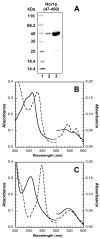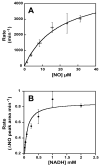Spectroscopic and kinetic studies of Nor1, a cytochrome P450 nitric oxide reductase from the fungal pathogen Histoplasma capsulatum
- PMID: 18804446
- PMCID: PMC2603478
- DOI: 10.1016/j.abb.2008.09.001
Spectroscopic and kinetic studies of Nor1, a cytochrome P450 nitric oxide reductase from the fungal pathogen Histoplasma capsulatum
Abstract
The fungal respiratory pathogen Histoplasma capsulatum evades the innate immune response and colonizes macrophages during infection. Although macrophage production of the antimicrobial effector nitric oxide (NO) restricts H. capsulatum growth, the pathogen is able to establish a persistent infection. H. capsulatum contains a P450 nitric oxide reductase homologue (NOR1) that may be important for detoxifying NO during infection. To characterize the activity of this putative P450 enzyme, a 404 amino acid fragment of Nor1p was expressed in Escherichia coli and purified to homogeneity. Spectral characterization of Nor1p indicated that it was similar to other fungal P450 nitric oxide reductases. Nor1p catalyzed the reduction of NO to N2O using NADH as the direct reductant. The K(M) for NO was determined to be 20 microM and the k(cat) to be 5000 min(-1). Together, these results provide evidence for a protective role of a P450 nitric oxide reductase against macrophage-derived NO.
Figures





Similar articles
-
Identification of Histoplasma capsulatum transcripts induced in response to reactive nitrogen species.Mol Biol Cell. 2005 Oct;16(10):4792-813. doi: 10.1091/mbc.e05-05-0434. Epub 2005 Jul 19. Mol Biol Cell. 2005. PMID: 16030248 Free PMC article.
-
Isotopic fractionation by a fungal P450 nitric oxide reductase during the production of N2O.Environ Sci Technol. 2014 Sep 16;48(18):10707-15. doi: 10.1021/es501912d. Epub 2014 Sep 5. Environ Sci Technol. 2014. PMID: 25121461
-
Stopped-flow kinetic studies of electron transfer in the reductase domain of neuronal nitric oxide synthase: re-evaluation of the kinetic mechanism reveals new enzyme intermediates and variation with cytochrome P450 reductase.Biochem J. 2002 Oct 1;367(Pt 1):19-30. doi: 10.1042/BJ20020667. Biochem J. 2002. PMID: 12079493 Free PMC article.
-
Kinetic characterization of the Escherichia coli nitric oxide reductase flavorubredoxin.Methods Enzymol. 2008;437:47-62. doi: 10.1016/S0076-6879(07)37003-1. Methods Enzymol. 2008. PMID: 18433622 Review.
-
Nitric oxide reductase (P450nor) from Fusarium oxysporum.J Inorg Biochem. 2005 Jan;99(1):185-93. doi: 10.1016/j.jinorgbio.2004.09.018. J Inorg Biochem. 2005. PMID: 15598501 Review.
Cited by
-
Talaromyces marneffei simA Encodes a Fungal Cytochrome P450 Essential for Survival in Macrophages.mSphere. 2018 Mar 21;3(2):e00056-18. doi: 10.1128/mSphere.00056-18. eCollection 2018 Mar-Apr. mSphere. 2018. PMID: 29577082 Free PMC article.
-
Quantum mechanical modeling: a tool for the understanding of enzyme reactions.Biomolecules. 2013 Sep 23;3(3):662-702. doi: 10.3390/biom3030662. Biomolecules. 2013. PMID: 24970187 Free PMC article.
-
Revisiting old friends: Developments in understanding Histoplasma capsulatum pathogenesis.J Microbiol. 2016 Mar;54(3):265-76. doi: 10.1007/s12275-016-6044-5. Epub 2016 Feb 27. J Microbiol. 2016. PMID: 26920886 Review.
-
Histoplasma Capsulatum: Mechanisms for Pathogenesis.Curr Top Microbiol Immunol. 2019;422:157-191. doi: 10.1007/82_2018_114. Curr Top Microbiol Immunol. 2019. PMID: 30043340 Free PMC article. Review.
-
Fungal traits that drive ecosystem dynamics on land.Microbiol Mol Biol Rev. 2015 Jun;79(2):243-62. doi: 10.1128/MMBR.00001-15. Microbiol Mol Biol Rev. 2015. PMID: 25971588 Free PMC article. Review.
References
-
- Marletta MA. J Biol Chem. 1993;268:12231–12234. - PubMed
-
- Moncada S, Palmer RM, Higgs EA. Pharmacol Rev. 1991;43:109–142. - PubMed
-
- Wienberg JB. In: Nitric oxide and infection. Fang FC, editor. Kluwer Academic/Plenum Publishers; New York: 1999. pp. 95–150.
-
- Dedon PC, Tannenbaum SR. Arch Biochem Biophys. 2004;423:12–22. - PubMed
-
- DeGroote MA, Fang FC. In: Nitric oxide and infection. Fang FC, editor. Kluwer Academic/Plenum Publishers; New York: 1999. pp. 231–261.
Publication types
MeSH terms
Substances
Grants and funding
LinkOut - more resources
Full Text Sources
Miscellaneous

